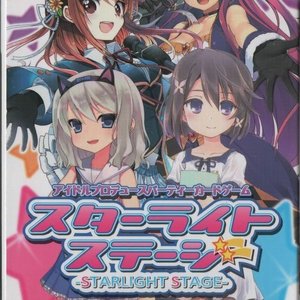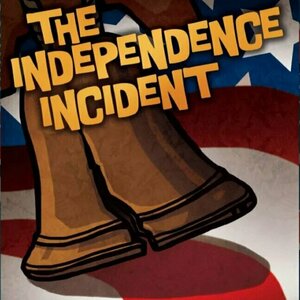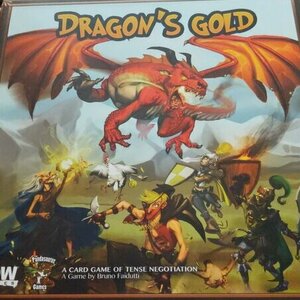
Dragon's Gold
Tabletop Game
Dragon's Gold is a game where you are fighting off dragon's in an attempt to take their gold....
Negotiation Board Game Tabletop Game Dragon's Gold
Purple Phoenix Games (2266 KP) rated Starlight Stage in Tabletop Games
Jul 25, 2019
DISCLAIMER: I do not intend to cover every single rule included in the rule book, but will describe the overall game flow and major rule set so that our readers may get a sense of how the game plays. For more in depth rules, you may purchase a copy from the publisher directly or from your FLGS. -T
Starlight Stage is a deck building, card drafting, and set collection game with a very unique theme and art style. As with all deck builders, players start with a hand of beginner cards. In this case, all players are dealt the same hand of starter idol, model, and actress cards. These are collectively called “Idols,” which is confusing, but I will address that in my summary. Essentially, each different type of idol provides you with a different type of currency/energy/power/resource to use when buying or drafting newer, more powerful cards.
On your turn you MAY flip over a card from one of the three decks available – Idol, Fame, or Event cards. Then you play cards from your hand in order to acquire more cards from the offer rows. Typically, you may only use one idol card per purchase, unless you are purchasing an Event card – you may send more than one idol to an Event. If there are no cards that you want, or that you can afford to purchase, you may “take a lesson,” by grabbing a resource token.
Tired of using just the starter idol cards all the time? Idols may reinvent themselves to become stronger. You do this by exchanging your starter (or upgraded) idol card and adding supporting cards and tokens to purchase a stronger idol card. These will typically provide more currency used to purchase more and better cards from the offer rows as well as providing more end game VPs. Example (shown below): exchange your starting Model idol card (blue diamond) plus several other supporting cards and tokens to transform your current Model into Super Idol Saori Tenkawa, who now provides you with one of each resource each time she is played.
Play continues until the Fame deck runs out, and points from cards are tallied to determine the winner.
Components: This game is a ton of cards and some resource tokens. The cards are great quality and will hold up well to repeated use, but super fans of the game may want to sleeve them, as the cards will be handled quite a bit. The tokens are typical cardboard chits and feature the diamond, heart, or music note symbols that are used throughout the game. Overall, production quality is pretty good.
So here’s the rub. When I pulled this out to play with Josh and Laura, we were immediately impacted by the art on the cards. When I started to explain the game mechanics and flow, Laura just COULD NOT contain her giggles as I tried to tactfully cover how to make your girls do jobs and attend events so that they can later upgrade themselves. I have to admit, the theme is not one I am accustomed to nor one that I can really get behind. I understand I come from a different culture background than that which is depicted in this game, but the theme is a definite detraction for us. Similarly, the art on the cards ranges from cute and uniquely anime to outright demeaning and near softcore hentai (there is no real NSFW artwork on the cards, but I certainly will not be playing this with my son until he’s at least 18). The idea of employing only young females and assigning them to different jobs to gain more fame or sending them to photo shoot events in skimpy clothing is just not very PC and not very 21st Century American. Again, I cannot stress enough that I do understand where this game comes from and the intended audience, but that intended audience is certainly not a group of highly inclusive, mostly minority, LGBTQIA member and allies, gender equal, 30-something board game enthusiasts and reviewers.
That said, the game itself can provide an interesting play session, but I highly recommend only playing with a specific group of people that you know will tolerate its suggestive art and overtones. For us at Purple Phoenix Games, we suggest Starlight Stage consider reinventing itself with a different theme. Also, I think some alternate terminology could be used for the Idol deck of cards that contain Idol, Model, and Actress cards. A minor quip, but it should be stated. Perhaps with some “Americanizing,” or at least having it be more PC, it would then overcome its 6/18 score and be invited to Hollywood with Simon Cowell.
Purple Phoenix Games (2266 KP) rated Bob Ross: Art of Chill Game in Tabletop Games
Jun 30, 2021
Bob Ross: Art of Chill is a set collection, hand management, card drafting game that has its players attempting to complete masterful paintings before the master does in order to collect bonus “chill points” to win the game. Whomever manages to reach ultimate chill status will be victorious and can return to feeding Peapod, their rascally pocket squirrel.
To setup, place the easel and one of the shuffled painting panels upon it. Place the other panels (paintings) nearby. Place the main scoreboard nearby as well and place the shuffled Chill Cards on its space upon the board. The Technique Cards deck and the Art Supplies Card decks will be shuffled separately and placed below the board with four cards from each deck revealed as an offer. Place the Bob Mover (Bobeeple) on the easel in the first location printed on the panel. Each player will receive a palette, the scoring cube of their color to be placed on the scoreboard, the three Feature Markers, and three random Art Supplies Cards. The game may now begin!
On a turn players will be rolling the Bob die and carrying out its action. These actions are playing a paint card from hand onto their palette, drawing one Art Supplies Card from the deck to their hand, performing one free Action prior to the Action phase, or resolving the Bob die face. The Bob die face requires players to reveal a new Chill Card and resolve its immediate effects, or effects that will remain in play until a new Chill Card is revealed. Secondly, the Bobeeple will move to the next printed stopping point on the panel.
Once the die has been rolled and resolved, the active player will be able to take any three actions available in any order: Draw an Art Supplies Card (from the deck or from the offer), Sweep the Art Supplies Card (discard all face-up cards and reveal four new ones), Apply Paint to Your Palette (by placing it on your palette from your hand of cards), Wash Your Palette (by discarding cards from one of the palette areas to clear it), Earn a Technique Card (by discarding two like-cards from the hand of cards in order to score more VP for painting features in the future), or Paint a Feature (by discarding the required brush from the player’s hand of cards and the correct matching paints already applied to their palette).
Once complete, the next player will take their turn of rolling the die and completing three actions. Should players paint a feature on the panel before Bob moves to that spot on the panel the player(s) will gain extra bonus Chill points. Players may still paint features for points if Bob already has as well, they just will not receive the bonus Bob points. Turns will continue in this fashion until the moment one player has reached ultimate Chill and won the game.
Components. This game has a fair amount of components and I am happy to say they are all great! The cardboard components (palettes, score board) are good. The cards are all lovely linen-finished. The other player components are fine as well. The painting panels are excellent and feature actual Bob Ross masterpieces, and there are 15 double-sided panels in the box! The coolest component is certainly the easel though. It seems to be a somewhat real and functional easel (not that you would really want to paint on it) and it amps up the table appeal when setup and in play. I love the components and I am so glad that Big G Creative made a Bob Ross game with beautiful components. Anything less would be sacrilege.
It probably comes as no surprise that I love this game. I have always loved watching Bob Ross from when I was a child even up through my adulthood and I am relieved to be able to still watch him in action via Netflix. The game, though, is rather surprising. I certainly wasn’t expecting to like this as much as I do and was quite shocked to find out that there was actual substance in a Bob Ross game. Especially when it was stationed next to “games” like Who Wants to Be a Millionaire, Throw Throw Burrito, and the like. I enjoy the nostalgia in seeing my favorite colors in my hands like Phthalo Blue, Cadmium Orange, and Sap Green.
I don’t know if I would really consider this a gateway game, though I believe it really depends on the gamers with whom you are playing. There will be many times when you are concentrating on collecting the colors needed to finish a feature before Bob only to frustratingly never see that color on offer nor in the cards you draw and then the painting has to be refreshed because people can’t seem to stop rolling Bob on the die. However, if you play with people who can literally chill when things don’t go their way, this is a gem. Purple Phoenix Games gives Bob Ross: Art of Chill a 21 / 24. The only thing missing here is a way to, “beat the devil out of it,” and it would make my heart sing.
Purple Phoenix Games (2266 KP) rated Quests: Heroes of Sorcado in Tabletop Games
May 26, 2021
Disclaimer: For this preview, we were provided with a Tabletop Simulator file for the demo/prequel adventure. These are not the final components, since it is a digital file, but the artwork and rulebook are mostly finalized – so the gameplay is what you will get in the physical copies of the game. -L
Quests: Heroes of Sorcado is a cooperative, campaign-driven game in which 1-6 players will take on the roles of party members with the goal of completing all 8 of the included adventures. The game does come with a tutorial/prequel adventure to help introduce players to the mechanics and overall gameplay before diving in to the full game. To setup for this Adventure Zero, place the game board within reach of all players, set aside the Campaign and Adventure books, place the Boss card for this adventure face-down above the board, and sort and place Potion/Loot/Armor/Health tokens in their corresponding areas. Set the 6 required Adventurers for the prequel in a circle near the game board, and take the listed Health and Starting Equipment for each Adventurer. The prequel uses only a single Location, so set that Deck in one of the Location spaces of the board, and the game is now ready to begin!
Depending on the player count, everyone will take on the role of at least one of the Adventurers, and the game itself is wholly cooperative. Here is how Adventure Zero works. Each Adventurer, in clockwise order, will be dealt 1 face-down Location card. Then, starting from the first dealt Location card, the Adventurers will take turns revealing their card. Some cards are Events or Story Moments, and prompt players to read from the Adventure/Campaign books. These cards often describe a scenario and require the player to select one of several provided choices, either earning a reward or penalizing the group. Most cards are Monster cards and will begin a combat! Each of the Adventurers has varying values for the four Stats of the game: Strength, Intelligence, Dexterity, and Wisdom. Combat in the game involves rolling a d20 and adding the appropriate Stat modifiers to the roll. You can also use Potions and Equipment to buff your rolls as well. How do you determine success or failure? Every Monster has a weakness to a specific Stat, so you will use that Stat modifier to enhance your rolls. Equal or exceed the Monster’s weakness, and it is defeated! Depending on the difficulty/level of the Monster, you will either fight with 2-6 Adventurers – adding their modifiers and abilities to your roll as well. How you setup your Adventurers is important, as adjacency is what helps determine who can be in each combat. If you defeat a Monster, collect the reward (Loot tokens, Potions, or Treasure cards), and the game continues to the next player. If you lose the fight, the Monster moves to the next Adventurer and combat begins anew. Once every Location card has been revealed and resolved, the Adventurers will reveal the Boss card and the final combat begins! Even though each combat has one primary Adventurer/player at the helm, the game is cooperative, so make sure you’ve got that teamwork mentality!
I have to say that I was pleasantly surprised by Quests: Heroes of Sorcado. The gameplay may seem a bit involved at first, but it actually flows pretty seamlessly and effortlessly. As someone who has played a handful of other campaign-driven board games before, I have to say that this one was by far the easiest for me to learn and play. Resolve Location cards, beat Monsters, and (hopefully) defeat the final Boss. Pretty straight-forward, and I really appreciate that. One thing that helps make it so user-friendly is that the game is based on only 4 Stats, instead of every conceivable Stat used in other role-playing games. That helps keep the game uncomplicated, while still offering players options every turn. Another thing that I really like? The Campaign/Adventure books are pre-written stories, prompts, and scenarios that allow the game to be truly cooperative. No need for an all-knowing Game Master here, as everything is already laid out for you. I also really like these pre-written aspects because it helps deliver the role-playing feel without pressuring the players to create their own campaign. Yes, there are still some ‘choose your adventure’ elements to it, but it doesn’t give so many options to overwhelm players.
That being said, I do have to mention that this is a campaign-driven game, so you will know the main storyline after your first complete playthrough. Although you would know the Monsters/Events/Boss/etc. of each adventure, the shuffle and draw of the decks would allow for variability, and thus replayability. You know the all the twists in the story, but will be able to play with different hero combinations as well! All 8 adventures will take quite some time to complete though, so don’t let the fact that you’ll know the main storyline after one playthrough turn you off from the game completely! Normally, I like to talk about the components of a game. Since this was a Tabletop Simulator version of the game, I am unable to really do so. I will commend the artwork and style of the game though – it is very thematic, engaging, colorful, and fun to look at. The text and abilities are clear, I love the color-coded modifiers, and the cards are all pretty intuitive. I have no doubts that the physical copies of the game will be quality productions as well.
As I stated above, this preview only covers the demo/prequel adventure, and its real purpose is to introduce players to the gameplay. That being said, I know that the full adventures will offer players additional elements (Side Quests, trading Loot and Potions, ‘level up’ the Adventurers, etc.) that will just add to the experience. Yes, there is the ‘one and done’ aspect of a campaign-driven game, but there is so much content in the full game to keep you going for quite a long time. If you’re looking at getting into this genre of game, but are worried about complexity, I would highly recommend Quests: Heroes of Sorcado. The gameplay overall is simple and straight-forward, while still offering the epic campaign feel. This one hits Kickstarter today, so head on over and check it out for yourself!
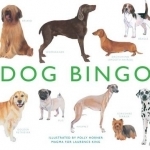
Dog Bingo
Book
This beautifully illustrated bingo game features 64 breeds of dog from around the world. Spot...
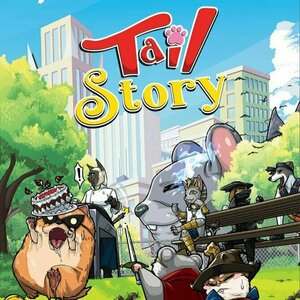
Tail Story
Tabletop Game
Tail Story is the story of the pets who dream to spend their daily lives differently. In this...

Clue Solver - for Clue or Cluedo board games
Games and Reference
App
Never lose at Clue/Cluedo again! This app is the ultimate Clue tracker and solver. You simply...
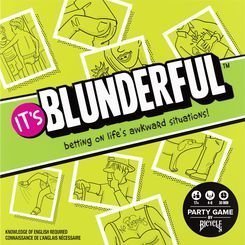
It's Blunderful
Tabletop Game
It’s Blunderful is a party game where you bet on how others would respond to awkward situations....
Purple Phoenix Games (2266 KP) rated The Independence Incident in Tabletop Games
Jul 2, 2021
The Independence Incident is a 4th of July(ish)-themed escape room type card game. It consists of 18 cards and I will be darned if it isn’t just great.
DISCLAIMER: We were provided a copy of this game for the purposes of this review. This is a retail copy of the game, so what you see in these photos is exactly what would be received in your box. I do not intend to cover every single rule included in the rulebook (as there is none), but will describe the overall game flow and major rule set so that our readers may get a sense of how the game plays. For more in depth rules, you may purchase from your FLGS. -T
To setup, open the flaps of the box containing the cards, navigate to the provided website to launch a web-based companion app, and the game may officially begin!
As I do not wish to spoil anything about the game, I will merely state here that following directions, completing puzzles, and knowing a little something about American history will benefit players immensely. Sorry I cannot say more, I would rather you all experience it for yourselves.
Components. This game consists of 18 double-sided cards and a nifty little box to hold it all. The cards are all nice quality, and feature very specific artwork on them. I have no complaints about the components at all here. Grand Gamers Guild always provide great quality games.
Ok, be mad at me if you like, but I just cannot bring myself to go into great detail about the game mechanics, how to play, or what is really included. Just know that this is probably a game you will play once and pass along, or keep several years between plays so that it doesn’t become too repetitive and easy to solve.
That said, this is a great little card game filled with puzzles I can actually solve! Yes, I needed hints a few times (perhaps a few times too many, as my final score would indicate), but with plenty of time, a little help from some friends, and Trevor Rabin’s soundtrack in the background, I could have score way better.
If you are someone who enjoys escape room-style games and also a lot of Americana thrown in, this one is a must-buy. While you don’t get to steal the Declaration of Independence in the game, you still get the feeling of traipsing across Washington, D.C., to help solve the case/riddle/game. Purple Phoenix Games gives this one a stressful 5 / 6. If you are a fan of anything I have mentioned thus far, pick yourself up a copy today!
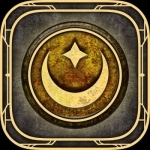
D&D Lords of Waterdeep
Games
App
*Cross platform online play! Join your friends on other platforms!* *New In-game chat feature. Stay...
